The Test & Our Results
With the limited game support for the Hydra and our limited time with the new drivers, we’ve had to throw out most of our usual video card testing suite. What we have here are games that are on the approved list and are at least somewhat graphically challenging, but by no means is it a complete list. As FRAPS and the Hydra software do not currently get along, we’re limited to games with built-in frame counters. This is also the reason that we will be doing an in-depth look at the image quality of the Hydra after CES, when we have more time to come up with ways to take screenshots.
Unfortunately our testing today will only paint a limited picture. The Fuzion board does not have SLI support, which means we cannot test a pair of NVIDIA cards in SLI and use that as a baseline for N-Mode performance. We’re hoping to track someone down from MSI here at CES in order to explain why the Fuzion doesn’t have SLI support, as this is a major oversight for a high-end board. Whether NVIDIA was willing or not to license SLI to MSI for the Fuzion is going to be the single biggest question hanging over our heads. Update: We have since received an official response from MSI. They did not implement SLI support as they felt the performance with Hydra was close enough to make SLI support unnecessary. We still find this questionable.
For our performance testing, we used the following games: Call of Juarez (DX10 benchmark), HAWX, Resident Evil 5, Company of Heroes, and Batman: Arkham Asylum. Batman is not supported under X-Mode, so we’ll leave it out of X-Mode testing.
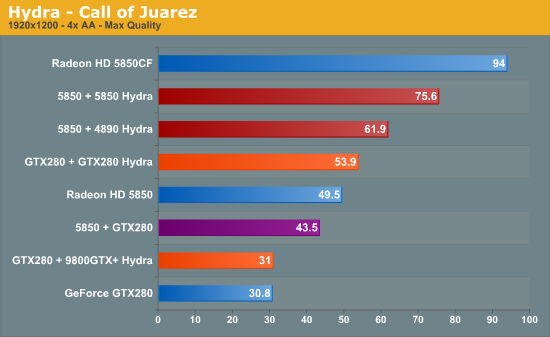
We’ll start with Call of Juarez, which is one of the Hydra’s better titles. With our 5850s in Crossfire, we get 94fps, which is just less than double the performance of a single 5850 (49.5). Right off the bat the Hydra takes a noticeable performance dive when using a pair of 5850s, splitting the difference between 1 and 2 cards with 75.6fps. Certainly it doesn’t look like Hydra can beat SLI/Crossfire, so it shouldn’t come as a surprise that Lucid and MSI aren’t claiming otherwise.
Moving to A-Mode with dissimilar video cards, we get some more definitive good news. Combining a 5850 and a 4890 gets us 61.9fps, a 25% performance improvement. This is less than the raw power of the 4890 (which is to say, in a perfect situation the 4890 performs at well more than 25% of a 5850) but it’s solid proof that this works.
As for the NVIDIA side, since we don’t have SLI results we’ll have to look at single-card and Hydra results. While 1 GTX280 gives us 30.8fps, a pair of them in N-Mode gives us 53.9, a 75% increase. This is much better than the increase we got on the 5850s, and much closer to the 100% theoretical max that we expect SLI is close to.
Switching to a GTX280 + 9800GTX+, things aren’t so rosy. The performance difference is practically absent at 0.2fps. While the Hydra technology scales worse the more mismatched a set of cards are, this is particularly awful.
Finally we have X-Mode using a 5850 + GTX280, with the AMD card as the master card. Here we get 43.5fps, which is slower than a single 5850. During this time we got significant microstuttering and striping in the image. Our best guess is that the Hydra was having trouble in the compositing phase, as the striping is a product of that. However in A-Mode and N-Mode we encountered no such issues. To the naked eye, Call of Juarez looked just as good in A-Mode and N-Mode as it does on a single video card.
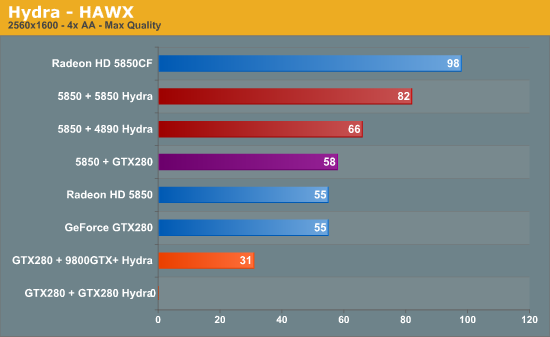
Moving to our old standby of HAWX, the picture is similar. Hydra performance on the 5850s is still below CF, but it’s still a 50% improvement. 5850 + 4890 is a 20% performance improvement. The GTX280s weren’t quite a success story however – HAWX crashed with a Lucid driver error when attempting to load the main menu of HAWX. Strangely the GTX280 + 9800GTX+ had no launch issues, rather the combination significantly underperformed the single GTX280 at -56%. Finally the 5850 + GTX280 came in at 58fps, which at a few fps faster than the lone 5850 is less than flattering.
Besides the single crash at no point did we see evidence of graphical corruption. HAWX always rendered correctly, even in X-Mode.
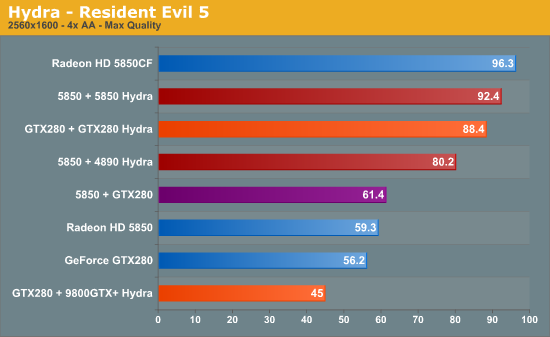
Resident Evil 5, in spite of being on the approved game list, was problematic for all Hydra modes. Every mode suffered from the same flickering problem (we suspect it’s lighting related), which doesn’t make the game unplayable but does make it annoying to play.
The performance however was very, very good. The 5850s got within 4% of CF mode, and the 5850 + 4890 still offered a solid 33% performance boost. The GTX280s did 57% better than a single GTX280, and the GTX280 + 9800GTX+ was the odd man out by losing performance. In X-Mode, the 5850 + GTX280 managed to squeak ahead of the single 5850 by 3.5%.
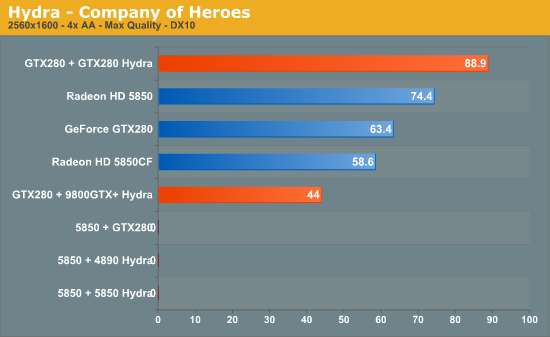
Company of Heroes is another game on the supported list that we didn’t have much luck with. There was no graphical corruption this time around, but instead it crashed on every mode involving an AMD card.
As for the NVIDIA cards, the GTX280s picked up about 30%, and the GTX280 + 9800GTX+ lost nearly the same 30%. There was no graphical corruption to report.
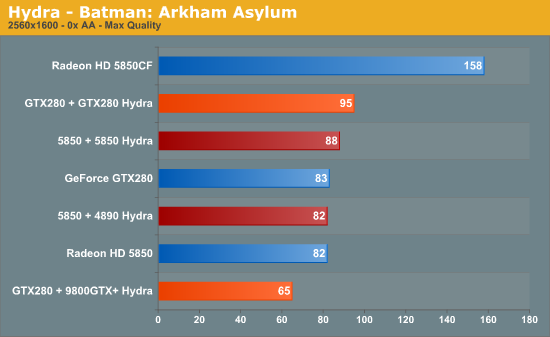
Finally we have Batman: Arkham Asylum, one of the most popular games of 2009. It doesn’t work in X-Mode, but does in N-Mode and A-Mode.
Unfortunately for the AMD cards, Lucid is having some scaling issues in A-Mode, something they do note in their release notes. A pair of 5850s is barely better than a single 5850, and a 5850 + 4890 flat-out isn’t better. The GTX280s pick up 15%, and the GTX280 + 9800GTX+ loses over 20%.
Frankly our testing experience was a mix of failures and successes, and this was sticking to the approved games list. Not a single game we picked to test worked perfectly in all cases, and the 1.4 driver release notes are a minefield of known issues. And unlike NVIDIA/AMD’s known issues, which tend to affect esoteric hardware and games, these are issues on what would be reasonably common high-end hardware configurations with popular games.
Here is by no means a complete list of games with known issues of graphical corruption: Call of Duty 4, World in Conflict (DX10), Rainbow Six Vegas 2, Operation Flashpoint Dragon Rising, Resident Evil 5. And as we’ve seen, this doesn’t include crashes, or undocumented graphical corruption.
We held off in doing significant testing on our Fuzion board until we had the 1.4 drivers in order to give Lucid time to get their next driver set out, since that set would be available when the hardware shipped. It was our hope in that moving from the 1.3 to 1.4 drivers that we’d see a reduction in graphical corruption compared to our tests in December when Lucid and MSI sent reps out, but that has not been the case.
This is by no means a complete list, and we aren’t going to claim otherwise. But in our testing thus-far, the Hydra drivers clearly need much more work. Frankly, we hesitate to think about what might have happened if the Fuzion shipped in November as originally announced.










47 Comments
View All Comments
krneki457 - Friday, January 8, 2010 - link
Sorry Ryan just noticed you wrote the article. Well it was just an idea how to get at least some SLI results with as little hassle as possible. Presuming Hydra can be turned off to work only as PCIe bridge, than this ought to work.chizow - Thursday, January 7, 2010 - link
Have you tried flashing the Trinergy BIOS for SLI support? It might kill off Hydra capabilities in the meantime and deprecate the Hydra 200 to its basest form, a PCIe controller but for purposes of measuring N-mode performance that should suffice. The other alternative would be to simply use the Trinergy with SLI results as a plug-in doppelganger since it is identical to the Fuzion, save for the NF200 vs. Hydra 200 serving as PCIe switches.jabber - Thursday, January 7, 2010 - link
I think it has some promise. I think the ultimate aim is to be able to 'cobble' together a couple of GPUs of similar capability, have them work efficiently together and not have to worry about profiles. The profiles could just be handled seamlessly in the background.If they can push towards that then I'll give them the time.
chizow - Thursday, January 7, 2010 - link
The technology does still rely on profiles though. You don't need to set-up game specific profiles like with Nvidia, even if that kind of granularity is probably the best option, your choices are limited to a handful of somewhat generic performance/optimization profiles provided by Lucid.The scariest part of it all is that these profiles will rely on specific profiles/drivers from both Nvidia and AMD too. I'm pretty sure its covered in this article, but its covered for sure in Guru3D's write-up. Hydra only plans to release updates *QUARTERLY* and those updates will only support specific drivers from Nvidia and ATI.
Obviously, depending on Lucid's turnaround time, you're looking at signficant delays in their compatibilities with Nvidia/ATI, but you're also looking at potentially 3 months before an update for an Nvidia/ATI driver that supports a newer game you're interested in playing. Just way too many moving parts, added complexity and reliance on drivers/profiles, all for a solution that performs worst and costs more than the established AFR solutions.
danger22 - Thursday, January 7, 2010 - link
maybe the amd 5000 cards are to new to have support for hyrda? what about trying some older lower end cards? just for interest... i know you wouldn't put them in a $350 mobovol7ron - Thursday, January 7, 2010 - link
I like the way this technology is headed.Everyone is saying "fail" and maybe they're right because they want more from the release, but I think this still has potential. I would say either, keep the funding going, or open it up to the community at large to hopefully adopt/improve.
The main thing is that down the road this will be cheaper, faster, better. When SSDs came out stuttering, people were also saying "fail."
shin0bi272 - Thursday, January 7, 2010 - link
I know how you feel but their original claim was scalar performance with a 7watt chip on the mobo. It's not even as good as standard crossfire (and probably not even standard sli) so that's what's prompting the fail comments. Instead of getting 75fps on call of juarez with a pair of 5850's they should be getting 99 or 100 according to their original claim. Dont get me wrong it functions and for a chip thats literally a couple of months old (maybe 24 since its announcement) thats great but the entire point of hydra was to do it better out of the box than the card makers were doing it.shin0bi272 - Thursday, January 7, 2010 - link
I had high hopes for this technology but alas it appears it is just not meant to be. Maybe its the single pci-e 16x lane they are using to try to feed 2 pci-e 2.0 16x lane video cards... just saying. Would have been nice to be able to keep my 8800gtx and add in a 5870 but oh well.AznBoi36 - Thursday, January 7, 2010 - link
Why would you spend $350 on this mobo and then spend another $350 for a 5870, just so you can use your old 800GTX with a minimal gain? You could spend $150 on a CF mobo, plus 2 4890's at $150 each for a total of $350 that would give a 5870 a run for it's money.shin0bi272 - Thursday, January 7, 2010 - link
oh and the reason for the 5850's is because I am really wanting the dx11 capabilities... I could go with 2 4890's and end up paying less yes but it wouldnt be dx11.